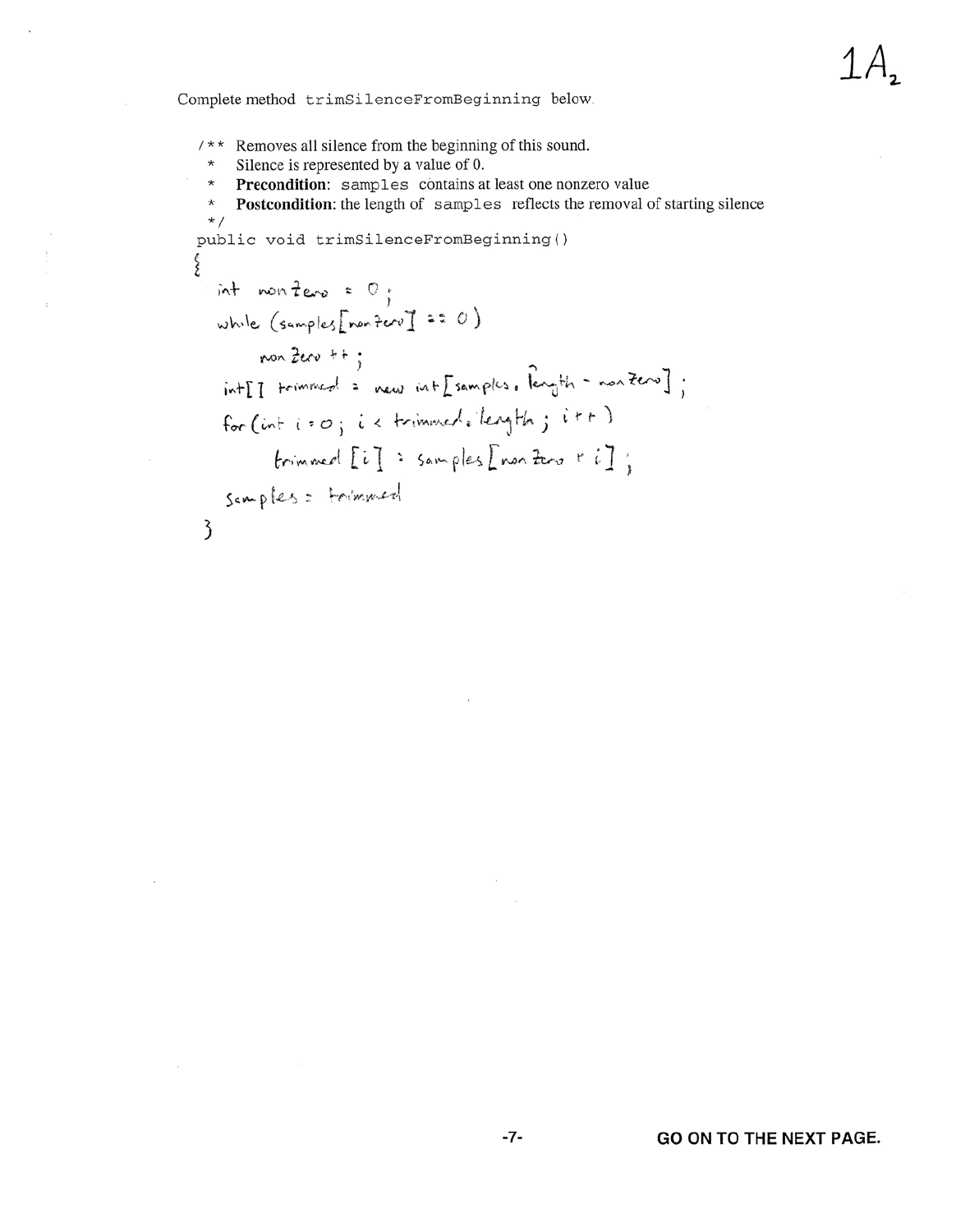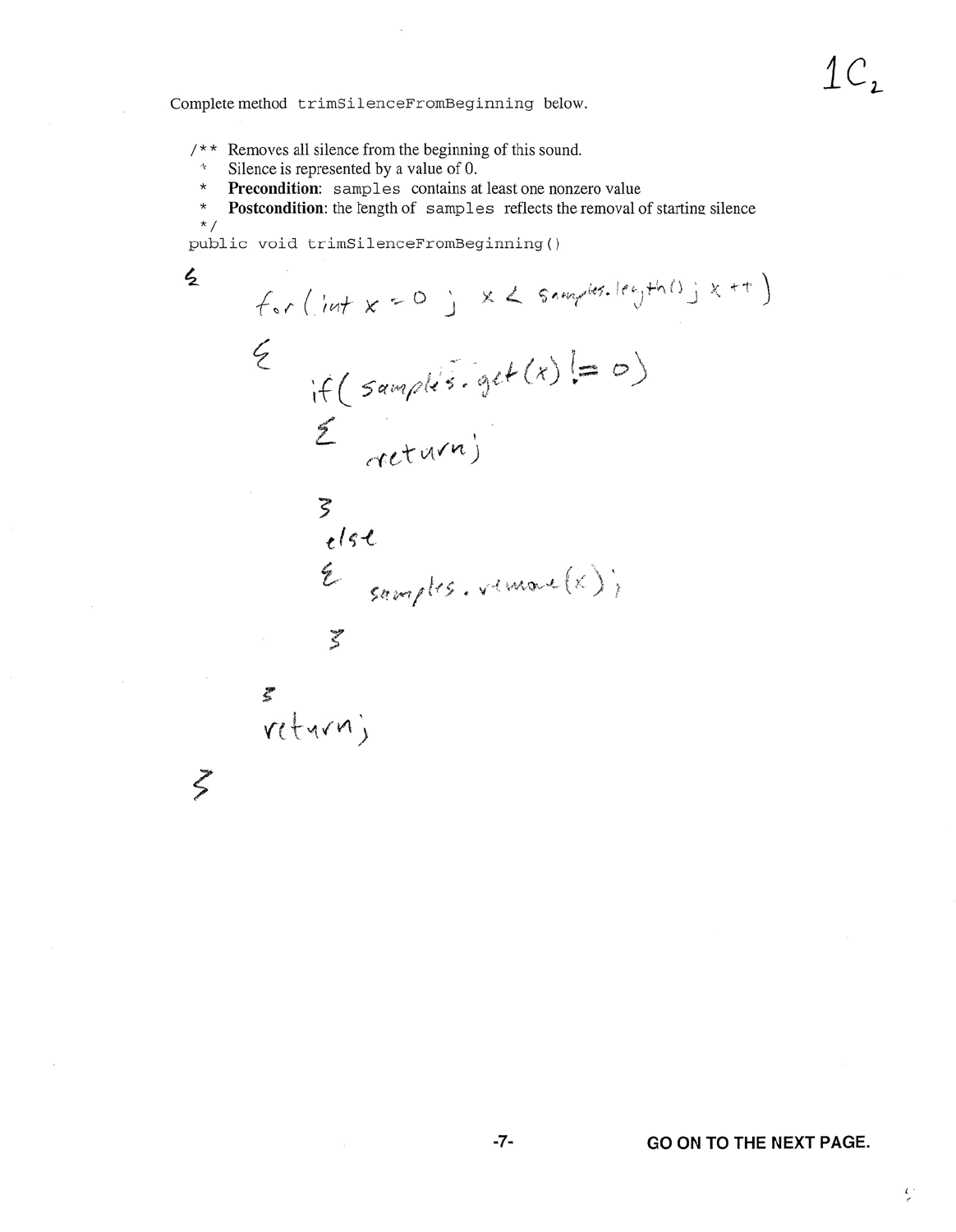
AP
®
COMPUTER SCIENCE A
2011 GENERAL SCORING GUIDELINES
© 2011 The College Board.
Visit the College Board on the Web: www.collegeboard.org.
Apply the question-specific rubric first; the question-specific rubric
always
takes precedence.
Penalties: The penalty categorization below is for cases not covered by the question-specific rubric. Points can only be
deducted in a part of the question that has earned credit via the question-specific rubric, and no section may have a negative
point total. A given penalty can be assessed only once in a question, even if it occurs on different parts of that question. A
maximum of 3 penalty points may be assessed over the entire question.
Nonpenalized Errors
spelling/case discrepancies if no
ambiguity*
local variable not declared if other
variables are declared in some part
use of keyword as identifier
[] vs. () vs. <>
= instead of == (and vice versa)
length/size confusion for array,
String, and ArrayList, with or
without ()
private qualifier on local variable
extraneous code with no side effect;
e.g., precondition check
common mathematical symbols for
operators (x • ÷ < > < > ≠)
missing { } where indentation clearly
conveys intent and { } used elsewhere
default constructor called without
parens;
e.g., new Critter;
missing ( ) on parameter-less method
call
missing ( ) around if/while
conditions
missing ; when majority are present
missing public on class or
constructor header
extraneous [] when referencing entire
array
[i,j] instead of [i][j]
extraneous size in array declaration,
e.g., int[size] nums = new
int[size];
Minor Errors (½ point)
confused identifier (e.g., len for
length or left() for getLeft() )
local variables used but none declared
missing new in constructor call
modifying a constant (final)
use of equals or compareTo
method on primitives, e.g., int x;
…x.equals(val)
array/collection access confusion
([] get)
assignment dyslexia,
e.g., x + 3 = y; for y = x + 3;
super(method()) instead of
super.method()
formal parameter syntax (with type) in
method call, e.g.,
a = method(int x)
missing public from method header
when required
"false"/"true" or 0/1 for boolean
values
"null" for null
Applying
Minor Penalties
(½ point):
A minor infraction that occurs
exactly once when the same
concept is correct two or
more times is regarded as an
oversight and not penalized.
A minor penalty must be
assessed if the item is the
only instance, one of two,
or occurs two or more
times.
Major Errors (1 point)
extraneous code that causes side effect;
e.g., information written to output
interface or class name instead of
variable identifier; e.g., Bug.move()
instead of aBug.move()
aMethod(obj) instead of
obj.aMethod()
attempt to use private data or method
when not accessible
destruction of persistent data (e.g.,
changing value referenced by
parameter)
use of class name in place of super in
constructor or method call
void method (or constructor) returns a
value
* Spelling and case discrepancies for identifiers fall under the “nonpenalized” category only if the correction can be
unambiguously
inferred from context; for example, “ArayList” instead of “ArrayList”. As a counterexample, note that if
a student declares “Bug bug;” then uses “Bug.move()” instead of “bug.move()”, the context does
not
allow for the
reader to assume the object instead of the class.

AP
®
COMPUTER SCIENCE A
2011 SCORING GUIDELINES
© 2011 The College Board.
Visit the College Board on the Web: www.collegeboard.org.
Question 1: Sound
Part (a) limitAmplitude 4½ points
Intent:
Change elements of samples that exceed ±limit; return number of changes made
+3 Identify elements of samples to be modified and modify as required
+1 Consider elements of samples
+½ Accesses more than one element of samples
+½ Accesses every element of samples (no bounds errors)
+2 Identify and change elements of samples
+½ Compares an element of samples with limit
+½ Changes at least one element to limit or –limit
+1 Changes all and only elements that exceed ±limit
to limit or –limit
appropriately
+1½ Calculate and return number of changed elements of samples
+1 Initializes and updates a counter to achieve correct number of changed samples
+½ Returns value of an updated counter (requires array access)
Part (b) trimSilenceFromBeginning 4½ points
Intent:
Remove leading elements of samples that have value of 0, potentially resulting in array
of different length
+1½ Identify leading-zero-valued elements of samples
+½ Accesses every leading-zero element of samples
+½ Compares 0 and an element of samples
+½ Compares 0 and multiple elements of samples
+1 Create array of proper length
+½ Determines correct number of elements to be in resulting array
+½ Creates new array of determined length
+2 Remove silence values from samples
+½ Copies some values other than leading-zero values
+1 Copies all and only values other than leading-zero values, preserving original order
+½ Modifies instance variable samples to reference newly created array
Question-Specific Penalties
–1 Array identifier confusion (e.g., value instead of samples)
–½ Array/collection modifier confusion (e.g., using set)
AP
®
COMPUTER SCIENCE A
2011 CANONICAL SOLUTIONS
These canonical solutions serve an expository role, depicting general approaches to solution. Each reflects only one instance from the
infinite set of valid solutions. The solutions are presented in a coding style chosen to enhance readability and facilitate understanding.
© 2011 The College Board.
Visit the College Board on the Web: www.collegeboard.org.
Question 1: Sound
Part (a):
public int limitAmplitude(int limit) {
int numChanged = 0;
for (int i = 0; i < this.samples.length; i++) {
if (this.samples[i] < -limit) {
this.samples[i] = -limit;
numChanged++;
}
if (this.samples[i] > limit) {
this.samples[i] = limit;
numChanged++;
}
}
return numChanged;
}
Part (b):
public void trimSilenceFromBeginning() {
int i = 0;
while (this.samples[i] == 0) {
i++;
}
int[] newSamples = new int[this.samples.length - i];
for (int j = 0; j < newSamples.length; j++) {
newSamples[j] = this.samples[j+i];
}
this.samples = newSamples;
}

© 2011 The College Board.
Visit the College Board on the Web: www.collegeboard.org.

© 2011 The College Board.
Visit the College Board on the Web: www.collegeboard.org.

© 2011 The College Board.
Visit the College Board on the Web: www.collegeboard.org.

© 2011 The College Board.
Visit the College Board on the Web: www.collegeboard.org.

© 2011 The College Board.
Visit the College Board on the Web: www.collegeboard.org.

© 2011 The College Board.
Visit the College Board on the Web: www.collegeboard.org.
AP
®
COMPUTER SCIENCE A
2011 SCORING COMMENTARY
© 2011 The College Board.
Visit the College Board on the Web: www.collegeboard.org.
Question 1
Overview
This question focused on array traversals, comparing array elements with a specified limit, and deleting
el
ements from an array based on a condition. Students were given a class containing an array, samples,
which contained sound values, and were asked to write two methods for processing those values.
The first method, limitAmplitude, required students to compare each element of the array to a
s
pecified limit, which was passed as a parameter. Values greater than limit were to be changed to
limit and values less than -limit were changed to -limit. The method also required students to
count and return the number of those changes made to the array.
The second method, trimSilenceFromBeginning, required students to create a new array that
con
tained the same values in the same order as the original array but without the leading zeros. The
solution required the instance variable samples to be updated to refer to the newly created array.
Sample: 1A
Score: 9
In part (a) the student correctly writes a loop that examines all elements of the array. The loop correctly
com
pares all elements to the limit value passed as a parameter, changes the value in the array when
necessary, and counts the number of changes made correctly. Variables are correctly initialized, and the
final count is returned. Part (a) earned all 4½ points.
In part (b) the first loop counts the number of leading-zero elements. An array of the determined length is
cr
eated. The second loop traverses the remaining elements of the array to fill the newly created array. The
instance variable samples is updated to reference the newly created array. Part (b) earned all 4½ points.
Sample: 1B
Score: 6.5 (rounded to 7)
In part (a) the student correctly writes a loop that examines all elements of the array. The loop incorrectly
compares elements to the value 2000 rather than the value passed as a parameter, resulting in no credit for
the comparison. The array element is changed to +/- limit, but the change is based on a bad
con
stant in the conditional, resulting in no credit for changing all and only elements. The student received
credit for initializing, counting, and returning the number of elements that were changed. Part (a) earned
3 points.
In part (b) the first loop counts the number of leading-zero elements. The code computes the number of
val
ues after the leading zeros but fails to create a new array. The code copies all the values other than
leading-zero values into the instance variable samples, but assigning null does not reduce the size
of the array. Part (b) earned 3½ points.
AP
®
COMPUTER SCIENCE A
2011 SCORING COMMENTARY
Question 1 (continued)
Sample: 1C
Score: 2
In part (a) the student uses a for-each
loop to traverse the array. This allows the code to access, compare,
and count the number of elements that exceed +/- limit appropriately but does not correctly change
t
he elements in the array. No credit was received for initializing and updating a counter, because the
student does not initialize the counter. Part (a) earned 2 points.
In part (b) the solution earned ½ point for co
mparing an element of the array to 0 but then was penalized
for get/[] confusion, as outlined in the General Scoring Guidelines. Because the remove method is
not defined for arrays, all of the remaining points were lost in this part. If the data structure had been an
ArrayList instead of an array, the remove method would have simplified the solution to the problem
significantly, because it does not require array manipulation. Part (b) earned 0 points.
© 2011 The College Board.
Visit the College Board on the Web: www.collegeboard.org.
